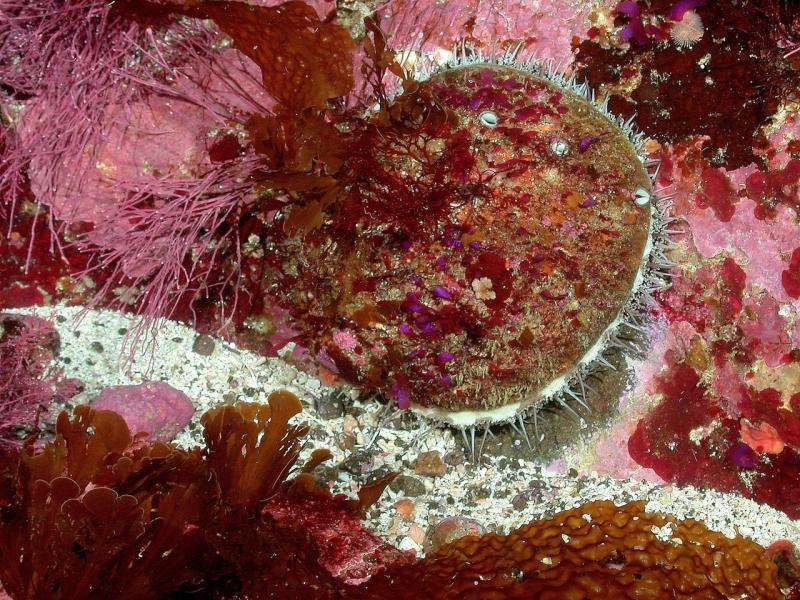Once so plentiful that commercial fishermen harvested them by the thousands, white abalone have virtually disappeared from the wild. Now researchers are planning to reintroduce some of the imperiled shellfish to their native California waters in the next few years, and want to give them the best odds of survival. To do that, they need to know what a healthy population looks like.
NOAA Fisheries has designated white abalone a “Species in the Spotlight,” one of eight marine species nationwide at high risk of extinction. Researchers have developed a special Action Plan of concerted recovery efforts by NOAA Fisheries and its partners to pull white abalone back from the brink and revive their numbers.
We highlight the effort today, on Endangered Species Day.
Improving Chances of Reproductive Success
Researchers want to know how dense the population of white abalone must be to successfully reproduce. White abalone are “broadcast” spawners, ejecting eggs and sperm into the water column where fertilization occurs. That means they face a natural dilemma: do they remain close to one another to ensure propagation of the species or do they travel away from one another and face less competition for food?
“The prevailing theory is that when abalone become adults and establish themselves in an area, they really don’t move much,” said David Witting, NOAA Fisheries biologist with the Office of Habitat Conservation. “But in nature, we don’t necessarily see that occurring with other closely-related species, like pinto abalone. Pinto abalone, which are not ESA-listed, share similar habitat requirements with white abalone, and they somehow manage to produce offspring even though densely aggregated adults are not always observed.”
Using Pinto as a Proxy for White Abalone
Witting and a team of scientists are using pinto abalone as stand-ins for white abalone in an underwater tracking study to understand how the shellfish move and disperse in the wild. Currently, the team is working with partners to propagate white abalone in laboratories and release them into the wild to help recover the species. From pinto abalone they are learning to understand how best to position individual white abalone in the wild when it’s time to release the endangered creatures.
“We have identified offshore habitat where white abalone once thrived and can again,” said Melissa Neuman, NOAA Fisheries Recovery Coordinator for white abalone. “We have animals born and raised in captivity that we can use to help rebuild populations in the wild, but in order to improve our chances of success with that effort we need to understand how white abalone might behave in a natural setting.”
The studies of pinto abalone will give researchers a better idea how many adult white abalone can be supported by kelp forest habitat in a specific area and what criteria to use to gauge whether the population is succeeding.
Tagging and Tracking Abalone Underwater
Researchers track the pinto abalone by harmlessly threading acoustic tags through respiratory ports on the outside of their shells. The tags emit signals detected by an array of audio receivers that surround the pinto abalone.
“Multiple receivers pick up the ‘pings’, and from that we can calculate the location of the abalone, taking into account the speed of sound under water, temperature, etc.,” said Witting. “Every time the tag ‘pings,’ we get a new position of the animal’s location which is recorded on the receivers.”

Researchers tagged their first group of 20 pinto abalone in late 2016 and tracked them for six months. When divers returned to gather the recording array, nearly all the abalone in that group’s area, including those tagged, had died along with the dense kelp bed, presumably due to the effects of warm El Niño water temperatures.
Researchers tagged a second group of 30 pinto abalone in late 2017 after El Nino conditions relaxed and water temperatures cooled. This time divers found most of the tagged animals alive and healthy, with some young offspring that indicated reproduction was occurring. While preliminary observations suggest some movement among these pinto abalone, a detailed analysis of the tracking information is underway.
Restoring White Abalone
“This pinto abalone research is so important because it really speaks to what we think we know versus what we don’t know about abalone, in general, and what drives their population dynamics,” said Witting. “We need to understand what a healthy and sustainable population of white abalone looks like in the wild.”
Permits to re-introduce white abalone to the wild are moving forward, as a captive breeding program builds a captive population of the endangered shellfish. Researchers hope to begin releasing some of the shellfish in test areas in the next year or two. The program to do so involves partners across the West Coast, from the Puget Sound Restoration Fund near Seattle to the Citizens Science Group of San Diego to the south.
“This has been a long road to reach the milestone of actually putting animals back out into the wild,” said Neuman, who has worked toward abalone recovery for nearly 15 years. “And the only way we’ve gotten this far is with the help of our partners in academia, federal and state agencies, and the private sector.”


